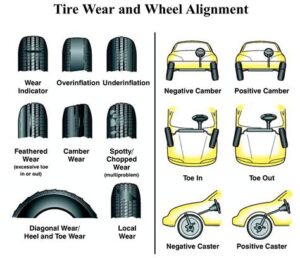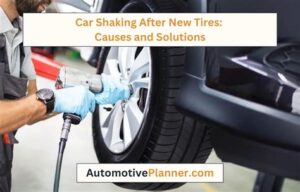Discover the importance of wheel alignment, its effects on tires, benefits, symptoms of misalignment, and how proper alignment enhances handling for safer driving.When it comes to maintaining your vehicle, one of the most crucial yet often overlooked aspects is wheel alignment. Proper alignment not only ensures a smoother ride but also significantly impacts your car’s overall performance and safety. Misalignment can lead to uneven tire wear, reduced fuel efficiency, and compromised handling. In this blog post, we will explore the importance of wheel alignment, the negative effects of misalignment on tires, and the numerous benefits that come from maintaining proper alignment. We’ll also highlight the common symptoms of poor wheel alignment and how it can improve your vehicle’s handling capabilities. Understanding these factors is essential for any car owner looking to enhance their driving experience and protect their investment.
Importance of Wheel Alignment
Wheel alignment is a crucial aspect of vehicle maintenance that affects your car’s performance, safety, and longevity. Proper alignment ensures that your vehicle’s wheels are adjusted to the manufacturer’s specifications, allowing them to work harmoniously with each other and the road. Neglecting this essential service can lead to significant issues over time.
When your vehicle is well-aligned, it enhances tire performance and significantly improves fuel efficiency. Misaligned wheels can cause your car to drag or pull to one side, leading to uneven tire wear and increased fuel consumption as the engine works harder to maintain speed. In contrast, proper alignment helps distribute the weight of the vehicle evenly, allowing for smooth and equal tire wear.
Moreover, proper wheel alignment contributes to enhanced safety while driving. Misalignment can impact your vehicle’s handling and response during turns, braking, and even during sudden maneuvers. This can lead to accidents or loss of control, making regular alignment checks a necessary part of safe driving practices.
Effects of Misalignment on Tires
Misalignment of your vehicle’s wheels can lead to a myriad of issues, particularly affecting your tires. When the wheels of a car are not aligned correctly, it results in uneven wear and potential damage, leading to a decrease in the overall lifespan of the tires. There are a few key effects of misalignment on your tires that every vehicle owner should be aware of.
Firstly, misalignment often causes tire wear to become uneven. Instead of wearing down uniformly, certain areas of the tire may wear faster than others, requiring more frequent replacements. This can be both costly and inconvenient. For instance, if the front tires are angled inwards or outwards, the inner or outer edges may wear down much quicker.
Additionally, misalignment can affect the traction and handling of your vehicle. As the tires wear unevenly, they may not grip the road effectively, causing potential safety hazards during driving, especially in adverse weather conditions. Regular checks and maintenance can help mitigate these issues, ensuring your tires stay in optimal condition and maintaining safety on the road.
Benefits of Proper Alignment
Proper wheel alignment is crucial for the overall health and performance of your vehicle. When your wheels are aligned correctly, it ensures that they are set to the manufacturer’s specifications, enhancing various facets of your driving experience. Here are some key benefits of maintaining proper alignment:
- Improved Tire Life: Proper alignment prevents uneven tire wear, significantly extending the lifespan of your tires. This can save you money in the long run by reducing the frequency of tire replacements.
- Enhanced Fuel Efficiency: When your wheels are aligned, your vehicle rolls more smoothly and easily, which can lead to improved fuel efficiency. Misalignment can cause your engine to work harder, consuming more fuel.
- Better Handling and Safety: Proper alignment allows your car to respond better to steering input, enhancing stability and control. This means a safer driving experience for you and your passengers.
- Reduced Wear on Suspension Components: Misalignment can put extra stress on your suspension system, leading to premature wear. Maintaining alignment can help in preserving the life of these components.
In addition to these practical benefits, proper alignment can also lead to a more enjoyable driving experience. With your car performing optimally, you’ll feel more confident behind the wheel.
Regular checks and adjustments of wheel alignment should be an essential part of your vehicle’s maintenance routine. By doing so, you can reap the rewards of better performance, safety, and savings on tire costs.
In summary, proper wheel alignment is not merely an aspect of vehicle upkeep; it is vital for ensuring efficiency, enhancing safety, and extending the life of your tires and other components. Prioritizing this maintenance will pay dividends in the long term.
Symptoms of Poor Wheel Alignment
Maintaining proper wheel alignment is crucial for the overall performance and safety of your vehicle. When a car is out of alignment, it may exhibit several symptoms that can help you identify the underlying issue. Recognizing these symptoms early can prevent further damage to your tires and suspension system.
One of the most common symptoms of poor wheel alignment is an uneven or rapid tire wear. If you notice that your tires are wearing more on one side than the other, it’s a sign that your vehicle may be out of alignment. Additionally, if your steering wheel is off-center when driving straight, it indicates that your alignment may be compromised.
Another clear symptom is a vehicle pulling to one side while driving. This can make your driving experience not only uncomfortable but also unsafe, as it requires constant correction of the steering wheel. Lastly, if you hear unusual vibrations or noises while driving, this could also point towards poor alignment, as misaligned wheels can cause imbalances that lead to these issues.





